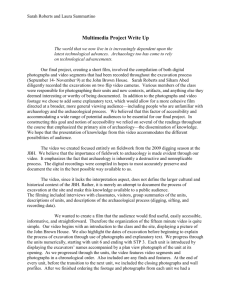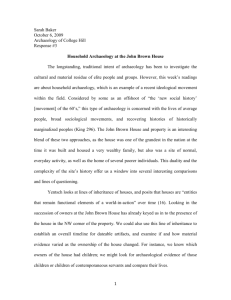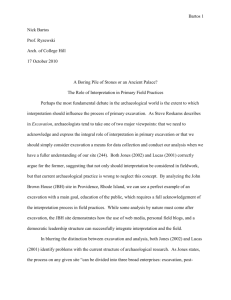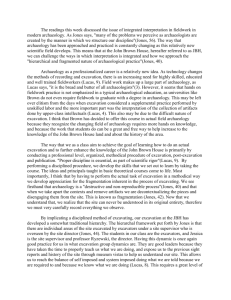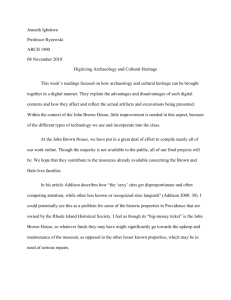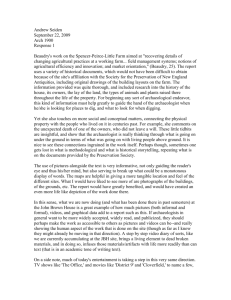Peter Hatch - unit 4 summary
advertisement
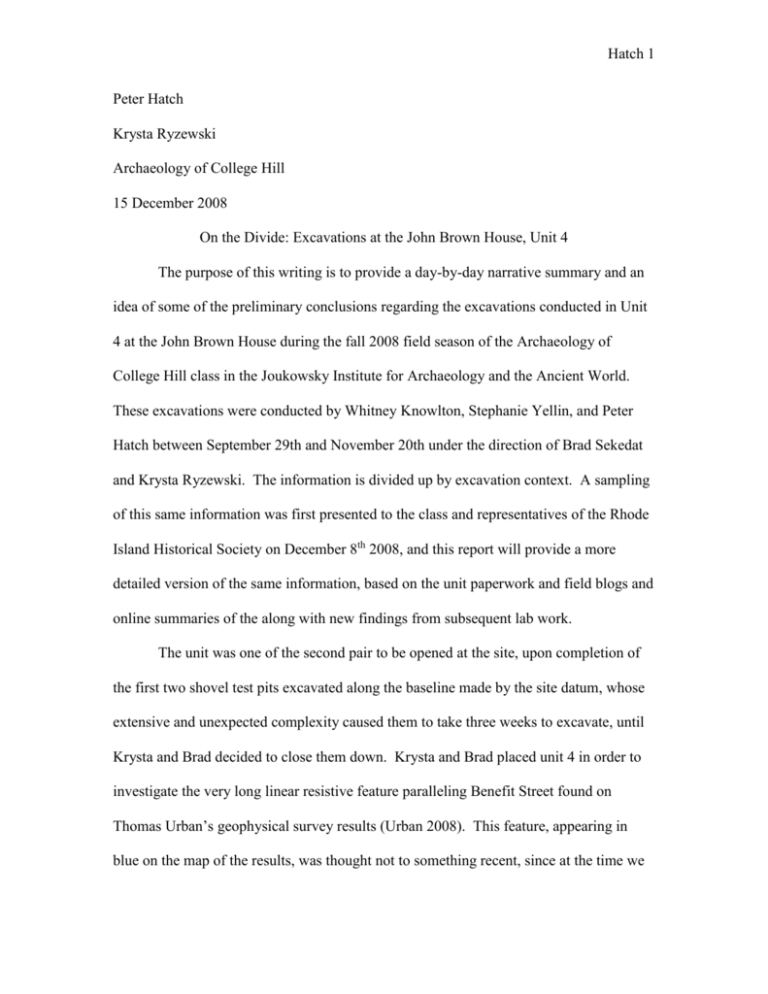
Hatch 1 Peter Hatch Krysta Ryzewski Archaeology of College Hill 15 December 2008 On the Divide: Excavations at the John Brown House, Unit 4 The purpose of this writing is to provide a day-by-day narrative summary and an idea of some of the preliminary conclusions regarding the excavations conducted in Unit 4 at the John Brown House during the fall 2008 field season of the Archaeology of College Hill class in the Joukowsky Institute for Archaeology and the Ancient World. These excavations were conducted by Whitney Knowlton, Stephanie Yellin, and Peter Hatch between September 29th and November 20th under the direction of Brad Sekedat and Krysta Ryzewski. The information is divided up by excavation context. A sampling of this same information was first presented to the class and representatives of the Rhode Island Historical Society on December 8th 2008, and this report will provide a more detailed version of the same information, based on the unit paperwork and field blogs and online summaries of the along with new findings from subsequent lab work. The unit was one of the second pair to be opened at the site, upon completion of the first two shovel test pits excavated along the baseline made by the site datum, whose extensive and unexpected complexity caused them to take three weeks to excavate, until Krysta and Brad decided to close them down. Krysta and Brad placed unit 4 in order to investigate the very long linear resistive feature paralleling Benefit Street found on Thomas Urban’s geophysical survey results (Urban 2008). This feature, appearing in blue on the map of the results, was thought not to something recent, since at the time we Hatch 2 had to existing record of what it might be, and its resistive (vs. conductive) quality indicated that it was not, for example, a pipe of some kind. It was not initially known from the geophysical survey exactly where, particularly at what depth, this feature would be encountered, and we tailored our excavation strategy accordingly. The unit was placed about 3m from the south end of where the linear feature began and about 4m from the fence and wall along the edge of Benefit Street, in order to fulfill this goal. The unit was purposefully not placed in a grid based on the site datum, but according to where the expected edge of the feature would be. The excavation strategy at unit 4 was also based upon a balancing of concerns between the need for good and accurate data collection and the practical limitations of our particular excavation schedule. The unit is 1m by 1m in size, for the purpose of providing a balance between covering a large enough area to be potentially variable within itself and a small enough area to be easily excavated by a small team over limited hours. Also this size unit was used for all of the others opened during this field season, creating the added benefit of making all four of them more easily comparable. It was decided that the unit would be excavated in a series of arbitrary 10cm levels, which could be freely reduced to adapt to the natural stratigraphy. The adoption of this common model for stratigraphic excavation proved a good basic model, but had to be adapted somewhat according to the practical concerns that arose from the specifics of excavating in unit 4. In terms of specific methodology it should be noted that we used trowels as opposed to shovels for almost all of the excavation unless specified otherwise, and we see this as evidence that our results are valid since our excavations were conducted with care. Hatch 3 Once unit 4 was placed, and the basics of the excavation strategy determined, work began in earnest on the fourth week in the field, Monday September 29th. String was drawn around the 4 corner stakes to delineate the boundaries of the unit, and the stakes were driven the rest of the way into the ground. The relative elevations of the stakes were observed, and the highest one (in the southeast corner) was selected to be the unit elevation datum, at which point a level line for taking elevation measurements was attached. Overall the top of the unit was relatively level but sloping slightly downward from the datum, with a difference of only 5cm between it and the lowest point, in the SW corner. With these preparations completed we designated our first context numbered, JBH 13, and began to dig. Context JBH 13 Excavation: This context was excavated entirely on the afternoon of September 29th, with the intention of it being a 10cm arbitrary context. The conditions on the day were warm and very humid, as a result of tropical storms that had passed through the area the in the days before. This left the soil very damp and had the result of breeding huge numbers of mosquitoes, which did not hinder progress in any measurable way and were dealt with partly with bug spray. We took photo #13 of the top of the unit. We continued by outlining the boundaries of the unit with our trowels. The turf was then shovel shaved off, and seemed to be composed mostly of grass and topsoil interspersed with “moss, twigs and roots” (Knowlton 2008), which hindered digging somewhat. The soil colors had a Munsell value of 7.5 YR 2.5/1, which may have been affected by the dampness of the day. Hatch 4 Soon after the excavation was underway, a natural change in the soil indicated that we were coming down upon a new soil context. This soil, compared to the topsoil, seemed to be dark and gravelly. This caused us to stop our excavations from going any deeper, and reformed our strategy to excavate according to the natural level. Using trowels we cleared down to the top of this new stratum in all parts of the unit. By our measurements this new stratum was 2-4 cm below the ground surface in the various parts of the unit. At the datum this layer ran from 0-3 cm, and at the center from 3-5cm. This new stratum was designated JBH 16. Artifacts and Dating: We screened all of the backdirt through ¼ inch mesh. In terms of artifacts, this context contained all modern debris, including two shards of plastic, a ballpoint pen and most importantly two pennies, which proved useful in dating the layer. These pennies, dated 1971 and 1967 provide the basis for our dating for this context, demonstrating with certainty that the topsoil and turf must have been deposited after the date on the later of the two, a solid terminus post quem date. Because of the relatively uniform appearance of the turf across the yard, it seems very possible that the TPQ date for this stratum at unit 4 could be applied more broadly to the yard itself, and that this could potentially be confirmed or refuted by investigation into any documentary record of landscaping work on the yard of the John Brown House property, if indeed such a record exists. Context JBH 16 Excavation: The top of this context was initially photographed, as photo #14, at the end of they day on September 29th, and then excavation of the unit happened at the beginning of the day on October 6th, or week 5. In terms of conditions, the official Hatch 5 summary of the day described the day as “cool and much more fall-like” and noted that “the ground was still damp” from recent weather (The Archaeology of College Hill 2008). The recent rains had not damaged our unit so we quickly began to excavate. For efficiency and speed, we shovel shaved instead of troweling to begin with. The soil was extremely gravelly, as it had first appeared to be, which was the main hindrance to digging quickly. In color it was measured in as 10YR 2/1. Once more just a few centimeters down we encountered what obviously appeared to be a new context, a large flat stone. We immediately observed that the stone seemed “angled in the direction of the linear feature from the geophys[ical survey]” (Hatch, Knowlton and Yellin 2008, 2). We suspected right away that this feature would be very important in the eventual interpretation of our unit, and it was designated feature 4. We leveled off the entire unit as carefully as we could with trowels. As we continued to excavate we noted a marked difference in the soil to the east and west of the new feature, being “mottled in color and free of gravel” with a loamy texture, measured as 10 YR 2/2 in color on average, although the color varied between orangish and brownish shades. This contrasted sharply with the gravel and dark grayish sandy soil that had overlain it, and seemed to continue in the same color–10YR 2/1–in the approximate area made by extending parallel lines from either side of feature 4, and a slightly lighter color but similar texture to the east, 7.5YR 3/3. This context, following natural levels, was between 3-6 cm thick throughout the unit and ran from 3-9cm at the datum and 5-10cm at the center. For continued work in subsequent weeks, the westernmost smooth soil was designated JBH 19, the easternmost gravelly soil JBH 20, and the darker gravelly soil in line with feature 4 became JBH 21. This separation that would prove to be key to our Hatch 6 continued work and subsequent analysis from that time onward, and the differences it is based on are illustrated in figure 1. Artifacts and Dating: Feature 4 was the main important find in this context, and certainly appeared to be the result of cultural rather than natural deposition, but of course it does not on its own provide temporal information, but rather a clue as to what was to be found later and the relationship of the unit to the results of the geophysical survey. Otherwise, there were fairly few artifact remains in this context. Most of the artifacts were parts of what became a familiar pattern of undiagnostic small shards of glass, brick and coal. The exceptions to this were two pieces of creamware, a type of refined earthenware that was produced between 1762 and 1820 (FLMNH 2008). It is likely that this context was deposited well after those dates because it directly underlies a stratum from at least 1971 and for other reasons covered later, but it can only be said with complete certainty that this context dates to after 1762. Finds in lower contexts could push this date significantly later, please see the subsection on JBH 37. Context JBH 19 Excavation: JBH 19 was first photographed on October 6th, with photo #18 (Figure 1), and not excavated until October 20th, after a break in the normal schedule in commemoration of the Columbus Day holiday. The conditions on the day were described as “a nice fall day with warm afternoon sun” (The Archaeology of College Hill 2008). We began the day with a summary of the previous weeks’ results, thorough short tours given to the rest of the class. We then chose to continue our excavations by moving to JBH 19, a sector of the unit on the west side bounded by a line extending along feature 4 and beyond it diagonally across the unit from approximately 50cm from the west edge Hatch 7 at the south and approximately 27cm from the west edge at the north. Elevations were taken at rough points near the corners and center of this section of the unit, rather than the whole unit (Hatch, Knowlton and Yellin 2008, 3) Because of the new smooth soil that this deposit represented, this unit was excavated as an arbitrary 10cm level into that new context. Trowels were used to excavate, given the relatively small area. The soil was mottled between shades of orangish-brown and dark brown, but was uniformly smooth and almost clayey in texture. It was noticeable that this type of soil had many more roots growing in it than the soil at the east of the unit, and these roots proved to be a significant obstacle to digging, requiring them to be cut off regularly at the floor and along the profile of the unit as we dug, using gardening shears. As we dug down the soil became more uniformly colored, but there was no clear transition to indicate the need to stop because of a natural level. The mottled layer later showed up as a distinct stratum, representing most of JBH 19 on the profile map made later. On average by the bottom of the 10cm context the soil was dark brown and 10YR 3/2 in color. As we began to overshoot our intended depth of 20cm all around in parts of the unit, we declared our arbitrary level finished. This context was between 6-11cm thick, with this unevenness being due to the fact that the top of the stratum was not level. In the southeast corner (used since the datum was not contiguous to the area excavated) this context ran from 1019cm and in the center of the section it ran from 11-21cm. The context below, to be excavated later, was initially designated JBH 26, and photographed in photo #22. There were noticeable similarities in terms of soil composition and artifact assemblage to lead to a comparison between this context and what was coming out of unit 3 at the same time. Hatch 8 Artifacts and Dating: This stratum did not produce very many artifacts, due mainly to it being a small part of the 1x1m unit. Although not noted on the unit paperwork, it was important to note that while excavating this context it was observed that feature 4 turned out to be “relatively thin...the bottom of it was only a couple of cm down” (Hatch 2008) which cast temporary doubt on its importance and relationship to the larger feature observed on the geophysical survey. We continued to find small pieces of brick and glass, and in addition found charcoal. The diagnostic artifacts in this context were two sherds of pearlware, manufactured from 1780 to1840 (FLMNH 2008). Additionally we found a large nail or stake that was heavily corroded, but appeared to be made with “cut nail” technology, as opposed to being hand-wrought, a technology which first appeared in 1790 (Edwards and Wells 1993). Therefore the TPQ for this context is 1790. Finds in lower contexts could push this date significantly later, please see the subsection on JBH 39. Context JBH 20 Excavation: On Saturday was October 25th the class hosted a Community Archaeology Day where visitors to the John Brown House were treated to a tour of the site. Visitors talked with members of the class, often offering their ideas and interpretations about what we were uncovering. For this day Kellie Slater was added to the normal excavation crew. This was very fun for those who participated, although its effects of the quality of archaeological data collected may have been mixed. In unit 4 for example a boy who was helping removed bricks that might otherwise have been left in place for longer, and since visitors require a large amount of energy there was not always enough time excavate efficiently or take careful notes. During this time and the Monday Hatch 9 that followed, context JBH 20 was excavated. Both days were described as “gorgeous sunny days with warm weather” (The Archaeology of College Hill 2008). The top of JBH 20 is recorded in photo #18, and it represents all of the eastern portion of the unit not excavated in JBH 19, since it was combined with JBH 21 which was initially designated as a separate context. The soil was very rocky. Underlying the gravel that had been initially visible were larger rocks and two large bricks whose location was mapped out on a sketched plan. Many pieces of brick and stone, and mortar turned up, which one excavator blogged as being “more foundational features” in due to the apparent relationship with feature 4 (Yellin 2008). When excavation resumed the following Monday, October 27th, this part of the unit was dug into further. As we dug further we began to find pockets of packed sand, some of which were white in color, 10YR 7/3, and others that were more of a brown sugar color, 10YR 5/4. A larger lump found was white at the center and surrounded by the brown sand, perhaps indicating that the two colors represented the same material/ We took this to be mortar of some kind. It was noted by that the composition of the soil was much like what was coming out of unit 5, which was a new unit opened on that Saturday. Overall somewhere upwards of 5cm of this context were excavated between the two days, going from 8cm to 13cm at the datum. An arbitrary split was made between this context and a new one, to allow for mapping a detailed plan of the architectural debris feature, which was later designated feature 6. Artifacts and Dating: It appears this context contained many artifacts, specifically the large quantity of architectural materials that were found, including two large bricks, and mortar, and various other materials. Notable among these finds were the sand mortar mentioned earlier, and a piece of mud brick that had an “impressed design” of parallel Hatch 10 lines in its fragile surface (Knowlton 2008). Kysta, from her experiences with other historical archaeology in the area, particularly with the Greene Farm Archaeology Project, noted this architectural rubble was similar to what had been observed there, with the debris possibly representing “the interior of a wall, which was probably two or three feet thick” (Knowlton 2008). Although these finds are interesting they do not by themselves give a firm indication of when this context was deposited and the architectural feature. The diagnostic artifacts that do bring us closer to a date were four sherds of plain creamware, which provides a TPQ date of 1762 (FLMNH 2008), and a large number of cut nails, which provide 1790 (Edwards and Wells 1993), the actual TPQ for this context. Finds in lower contexts could push this date significantly later, please see the subsection on JBH 37. Context JBH 21 – Unused This context appears on the context log, but was unexcavated. The decision was made when excavations into JBH 20 began that this context did not appear noticeably different from the area originally designated as JBH 20, and thus JBH 20 was expanded to include it. Context JBH 26 – Unused This context appears on the context log, and was photographed in photo #22, but was unexcavated. It appears on the excavation forms and was listed as a new arbitrary context to underlie JBH 19, to be used when we continued to dig on the west side of the unit. It was missed, and when excavation resumed on that part of the unit a new context number JBH 39 was used for the same area. In practice JBH 26 actually refers to JBH 39. Context JBH 37 Hatch 11 Excavation: JBH 37 was the arbitrary context excavated below JBH 20 on the east side of the unit. It was mapped on October 27th and November 3rd and the excavated to a limited extent on the 10th. It was initially created so that the architectural debris that started to appear more and more in JBH 20 could be mapped in clear detail. This author feels unqualified to perform any kind of detailed analysis as to what the results of this plan map might say as to the character of the rubble fill and what kind of feature it may be. The map was completed, with the measuring done mostly by the author, and drafting by Whitney Knowlton. The map (Figure 3) is included with this section. Unfortunately we made mistakes due to the shortened timeline of the last few field days that was significantly worsened by daylight savings time. First among these mistakes is that the mappers neglected to remember to add elevations on either the initial context form or the map, and that represents a hole in the data. Some elevations were recorded on November 10th, and that data should be taken into account. However a second context sheet that was begun for this context does have some elevations recorded, and so that data will be used where possible. In terms of conditions, the last two days of excavation began at 1:30 each afternoon to try to compensate for the rapidly failing light, and corresponding dropping temperatures. The whole of context JBH 37, because of its architectural fill, was designated feature 6 on November 3rd. The actual excavation done on JBH 37 was conducted November 10th. The soil was characterized as “very dark grayish brown” or 10YR 3/2, and characterized as “full of rocks and broken bricks” (Hatch, Knowlton and Yellin 2008, 5). The excavation plan was an arbitrary 10cm level, made by removing small rubble but leaving pedestals around larger pieces of brick. This proved “very difficult since the dirt Hatch 12 was relatively loose” (Knowlton 2008). In the end this level was not completed, and the elevations included were 15.5cm at the datum, 21.5cm written by the middle of the east wall, 18cm at the northeast corner and 9cm written in the middle of the north wall. These seem to reflect starting elevations, although it should be mentioned that the ending elevations are not too far below this. Artifacts and Dating: Much more architectural debris was removed from this layer, although some of it may have gone uncollected due to it being essentially the same as the assemblage found in overlying contexts. Other than this very few diagnostic artifacts were recovered, including 8 cut nails, again providing the possible TPQ of 1790 (Edwards and Wells 1993). The most interesting diagnostic artifact thus far was a tiny shard of milky colored glass, which only began to be produced in 1869 (CNEHA 2000). This is an obvious TPQ for the stratum, and much later than any diagnostic artifact from the two contexts above it. According to the principal of superposition, that newer deposits will overly older ones, this means that both JBH 16 and JBH 20 may also be later than 1869. A reanalysis of this artifact as something other than milk glass, or an argument as to how it may have been artificially introduced into this architectural rubble could yet change this date, but neither have been presented. In any case, its important to note that the artifact assemblage and general characteristics of this context continued to match a similar rubble-filed quality to unit 5. Context JBH 39 Excavation: This context was an arbitrary level to be excavated below JBH 19 in the western portion of the unit, on November 3rd, the next-to-last day in the field. Although the conditions of the day pushed the end of class to around 4:30 from the usual Hatch 13 5:20 due to daylight savings, we worked as best we could. Excavations were opened at 1:30 in the afternoon for those who could make it then, and “students trickled in” between that time and the scheduled start of class (The Archaeology of College Hill 2008). It was decided that based on soil and artifacts from the excavation of JBH 19 that were very much comparable to those from unit 3, we did not need to excavate the western side of the unit as carefully, and we would attempt to make this a 20cm context as opposed to the normal 10cm one. With that ambitious goal in mind we excavated as quickly as possible. Once more new elevation measuring points in each corner and the center of the section, as opposed to the whole unit, were added in. Our target elevation was 20cm below the current highest point, or 37 cm, but digging was once more hindered by the roots laced all through the soil, a constant problem in the western part of the unit. As we excavated we noticed that the artifact density seemed to be higher than in the contexts above, and “interesting finds included animal bone, a button, some pottery pieces” along with the usual glass, coal, and brick (Yellin 2008). Another mistake made in the rush of the last couple of days was that this layer lacked a soil description, but a later form for the context below described that soil as “same as above” and describe it as “dark gray-brown loamy soil” and 10YR 3/2 in color (Hatch, Knowlton, and Yellin 2008, 8) so it is reasonable to attach that description to the soil from this context. Indeed for the purposes of stratigraphic analysis this arbitrary context can be treated as the same as the one below it, JBH 42. This context was not completed to the full 20cm, but for the sake of efficiency a new context was opened for the last day. This context was between 10 and Hatch 14 13cm thick across the section and went from 19-31cm in the SE corner nearest the datum, and 21-31cm in the center. Artifacts and dating: As stated before this context had a large number of artifacts, which included a variety of things such as a small triangular piece of iron of unknown use, and a single brass button. Once more there was an example of a cut nail, two stakes in this case, dated after 1790 (FLMNH 2008). In terms of historic ceramics there were sherds of creamware and pearlware as had been observed in other contexts, which began to be produced in 1762 and 1780, respectively (FLMNH 2008). Also there was a single sherd of whiteware, which pushes only began to be produced in 1830 (FLMNH 2008). Finally, there was a small piece of white colored plastic, which Krysta interpreted as cellulose plastic, a fairly modern material that was not produced until 1855 (Wikipedia 2008), which would appear to be the TPQ date for this context. Again invoking the idea of superposition, it would seem that JBH 19 and JBH 16 above are also brought up to this date. It could be argued that this plastic was introduced by rodent disturbance since the surface seemed chewed, or by some other means, but there is no similar evidence for the whiteware that is roughly contemporary, so this date seems usable until further research is conducted. Context JBH 42 Excavation: The final context to be excavated at unit 4 during the first season was JBH 42, another arbitrary context below JBH 39 that was intended to get another 20cm down into the western section of the unit, just before excavation needed to be stopped for mapping and backfilling. The conditions of the day were again affected greatly by daylight savings time and an overcast day, which led to a notable lack of light to work by. Hatch 15 Even so “Brad and Krysta had to pry trowels away from” many of us, when digging had to cease at 3:30. We dug as quickly as possible, even using shovels in the small area being excavated. Once more there were problems with root disturbance that slowed excavation, and near the end an extremely thick tree root was discovered in the northwest corner of the unit. Otherwise the soil was the same smooth dark brown stratum as above, 10YR 3/2 in color. When excavation was halted, 7-10cm of the intended 20 had been removed, going from 31-39cm at the corner nearest the datum and 31-41cm in the center of the section. As digging down was conducted, we were also unstructed to cut into the wall on the east side of this section, below feature 4, to investigate what might be there in order to better connect feature 4 and feature 6, especially given how thin feature 4 had turned out to be. As we cut across we found “several large stones beneath” (Yellin 2008) feature 4, indicating that it was indeed just the top layer of an architectural feature that went much deeper. After excavations were stopped we took photos of the whole finished unit on all sides, and made a map of the profile at the south wall, chosen because we thought it showed the two halves of the unit and the extreme differences between them most clearly. These differences are also illustrated well by photo #44 (Figure 2). With this step quickly finished in the fading light we put a tarp in as carefully as possible backfilled the unit with the help of members from the other crews. Artifacts and Dating: Like JBH 39, JBH 42 contained a wider assortment and greater quantity of artifacts than the contexts above it. The large quantity of otherwise typical coal was notable. Glass shards and pieces of brick were recovered in the now familiar pattern. A wide variety of ceramic types were encountered in this unit. The plain pearlware was found, providing a TPQ of 1780 (FLMNH 2008). Several sherds of Hatch 16 a blue decoated pearlware were found as well, pushing the date back to 1780 (FLMNH 2008). A redware with dark brown glaze showed up as well, a type dating from 17001770 (FLMNH 2008). The latest sherd in the assemblage was a single piece of blue and white Canton porcelain, produced from 1790 to 1835 (FLMNH 2008). Thus 1790 can be considered a TPQ for this context, but there was no noticeable difference in soil composition between it and JBH 39 above, so it may be comfortably suggested that this context must also date to after 1855. Preliminary conclusions The most basic conclusion of our excavations is the clear difference between the contexts at the west side of the unit, which were characterized by smooth soil containing many roots, and larger numbers of diagnostic artifacts and the contexts east of feature 4, which were characterized by rocks and other apparent architectural debris, the manmade portions of which made up the artifact assemblage, resulting in fewer diagnostic artifacts. This difference was first visible on upon the excavation of JBH 16 and the finding of feature 4, and only became clearer as more excavation was conducted (see figures 1 and 2) and feature 6 was revealed. There are more conclusions to be made, on the basis of this information. Features 4 and 6 appear to both represent parts of a larger architectural feature, that seems to be rubble fill inside a more regularly built shell. Together these features are small parts of the large linear resistive feature observed in the geophysical survey results (see Urban, this volume) and this claim is made on the obvious difference between this architectural feature and the surrounding soil, and the orientation of the western edge of the feature, the boundary between the two halves of unit 4, almost exactly parallel to Hatch 17 Benefit Street as was the feature at the same location observed in survey. Therefore if we extend the line made through the middle of our unit, with the expectation that the feature will continue, we may say that is sits on the dividing line between the interior (on the east side) and the exterior (west side) of a larger architectural feature, likely a larger wall or the part of a structure of some kind. We can be firmer in this hypothesis given that the same difference seems to be illustrated in the difference between the smooth soil and large number of historic ceramic sherds recovered from unit 3, and the architectural rubble found in nearby unit 5 (see Nuding, this volume). The difference between these two units, several meters away, provides an illustration of just how large the overall architectural feature must be. Units 3 and 5 are important in another way in the attempt to determine the temporal context of the construction and use of this architectural feature. Because unit 4 was subdivided into smaller sections of a single 1x1m unit, the resulting artifact assemblages from each context are small. These collections are not amenable to statistical dating techniques like mean ceramic dating or mean artifact dating, because they are not large enough to produce valid or exact results. For the time being we are limited to TPQ dating which does not provide an exact timeline. However, since units 3 and 5 seem clearly associated with the two halves of this unit, if the stratigraphy of the two can be closely associated then the dates from strata that appear to carry over can potentially be applied to unit 4. This creates the potential for larger artifact assemblages that can be associated with one another and more exact dating will result. This is dependent on the conclusions of the stratigraphic analysis (see Combs, this volume). Hatch 18 Finally, documentary evidence will be useful in the continued attempt to learn more about the archaeological research at the John Brown House. At this time there seems to be evidence pointing to the architectural features we are finding across all of the units, and including the one in unit 4, being parts of a 19th century house at Benefit and Charlesfield Streets constructed while the property was owned by Robert Hale Ives (see Yellin, this volume). More information about this possibility, that should still be treated as tentative, but should definitely be investigated by future students of the Archaeology of College Hill. Summary Table ----------------------date soil color description top elev. (range) bottom elev. (range) feature(s) photo(s) taken ----------------------artifact giving date TPQ date source JBH 13 29 Sept. 7.5YR 2.5/1 topsoil 0-5cm 3-9cm none 13 JBH 16 6 Oct. 10YR 2/1 gravelly, black 3-9cm 7-12cm 4 14 JBH 19 20 Oct. 10YR 3/2 mottled, brown 8-12cm 17-21cm none 18,22 JBH 20 25-27 Oct. 10YR 2/2 gravel, lighter 8-?cm 13-?cm 6 18 U.S. penny 1971 on object creamware 1762* FLMNH nail - cut 1790* Edwards and Wells stakes - cut 1790* Edwards and Wells ----------------------date soil color description top elev. (range) bottom elev. (range) feature(s) photo(s) ----------------------artifact giving date JBH 37 27 Oct.-10 Nov. 10YR 3/2 rocky, dark 15.5-21.5cm ? 6 30, 44 JBH 39 3 Nov. 10YR 3/2 smooth, dark 17-21cm 29-31cm none none JBH 42 10 Nov. 10YR 3/2 smooth, dark 29-31cm 37-41cm none 44 milk glass TPQ date source 1869 CNEHA Plasic cellulose 1855 Wikipedia Canton Porcelain 1790* FLMNH Hatch 19 Figure 1. Photo #18, top of contexts JBH 19 and 20 QuickTime™ and a decompressor are needed to see this picture. Figure 2. Photo # 44, bottom of excavations as of November 10th QuickTime™ and a decompressor are needed to see this picture. Hatch 20 Figure 3. Plan 1 of the architectural rubble in JBH 37 Hatch 21 References Archaeology of College Hill. 2008. Excavation and Unit Summaries. Joukowsky Institute for Archaeology. http://proteus.brown.edu/archaeologyofcollegehill/6346. Council for Northeast Historical Archaeology (CNEHA). 2000. Telling Time in the Second Half of the Nineteenth Century. Ed. Lynda Bass. Florence, NJ. Florida Museum of Natural History (FLMNH). 2008. “Mean Ceramic Manufacturing Dates.” Artifact Identification Guide. Ed. Krysta Ryzewski and Brad Sekedat. Hatch, Peter, Whitney Knowlton, and Stephanie Yellin. 2008. Excavation Forms. Ed. Krysta Ryzewski and Brad Sekedat. Hatch, Peter. 2008. Archaeology of College Hill: Peter’s Field Blog. Joukowsky Institute for Archaeology. http://proteus.brown.edu/archaeologyofcollegehill/6515. Knowlton, Whitney. 2008. Archaeology of College Hill: Peter’s Field Blog. Joukowsky Institute for Archaeology. http://proteus.brown.edu/archaeologyofcollegehill /6498. Urban, Thomas. 2008. John Brown House Preliminary Geophysical Survey Report. Joukowsky Institute for Archaeology. http://proteus.brown.edu/archaeologyofcoll egehill/admin/download.html?attachid=4283873. Wikipedia. 2008. Plastic. Wikipedia Foundation, Inc. http://en.wikipedia.org/Plastic Yellin, Stephanie. 2008. Archaeology of College Hill: Peter’s Field Blog. Joukowsky Institute for Archaeology. http://proteus.brown.edu/archaeologyofcollegehill /6528.
